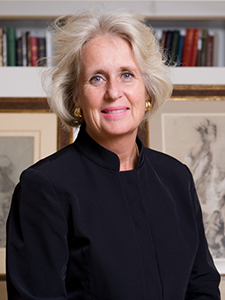November 20, 2015
BY JUDY CARMACK BROSS
True admiration is rare and to be shared. And admiration across the art world abounds for Suzanne Folds McCullagh, retiring for writing, family and travel after 40 years at the Art Institute of Chicago. Suzanne began as a curatorial assistant while completing her Ph.D. at Harvard and most recently has served as Anne Vogt Fuller and Marion Titus Searle Chair and Curator of Prints and Drawings for five years. Like the deepest admiration, the impact of her career is felt far beyond the amazing number of exhibitions curated, collections built and mentees trained. It affects the widest of circles due to the regard others hold for Suzanne.
“Suzanne knows everyone and is respected by all. She possesses both a social presence and professional knowledge which allow her to bring together for her seminars scholars, dealers, and collectors in a way that no one else could have,” John Bross said recently. “Her attractive character and noted scholarship has led to the acquisition by the Art Institute of major drawing collections from other cities as well as from Chicago.”
An elegant blonde with lovely blue eyes that never roam when she is talking with you, Suzanne shows a genuine desire to listen to what you have to say. She could do an immediate career transition to an ambassadorship. In fact, that is a role she has played for the Art Institute.
It is the people she has met through her work that she will most miss.
“The world of prints and drawings involves a wide circle of international friends, but it is very intimate and invites coziness. Scholars, curators and collectors visit the November Fair in New York, the collections at the end of January, and are in London in July,” Suzanne said. “We love to get together for symposia and dinners which are filled with camaraderie.”
The very delicate nature of drawings and prints attracts Suzanne.
“Drawings encourage you to look closely at things, they give you the insight of almost looking over the artist’s shoulder. Prints are very deliberate but yet delicately made. Both are miracles, and their survival rate amazing,” she explained.
Known for exciting exhibitions such as Rembrandt’s Journey, which attracted international fascination in 2004, she has curated major exhibitions of family collections.
“I have worked with Suzanne for most of her career, watching her grow from an assistant to a curator of major accomplishments. She literally grew up in the museum world,” noted professor and collector Jean Goldman said. “She is a supportive and informed colleague with whom I have co-curated two exhibitions, and I have traveled with her to so many auctions in London and New York. I worked with her closely when we endowed the Jean and Steven Goldman Galleries and Study Room with the result that this space is now universally acclaimed for its forward-thinking design.”
Suzanne directed and co-authored the first comprehensive scholarly catalogue on the period, Italian Drawings Before 1600 in the Art Institute of Chicago. She has published prolifically on subjects ranging from Rembrandt to Chardin to Chagall. After retirement, she will return to write about her first love, Parisienne printmaker Gabriel de Saint-Aubin, who lived from 1724 to 1780.
“I was introduced to him when I was an intern in 1974 when I saw an unpublished study. He never left Paris but captured the street life there in such charming ways,” she explained. “He was from an artistic dynasty. He tried unsuccessfully three times for the Prix de Rome and died in poverty. It was written that he used drawing chalk to powder his wig.”
Suzanne gives great credit to her predecessors as Curator of Prints and Drawings.
“I learned so much during my nine years with Harold Joachim, who served from 1958 until 1983, and then from Douglas Druick for 26 years,” she said.
Her professional associations and volunteer efforts are second to none. Suzanne has led seminars at the University of Chicago and taught in the fall of 2012 at her alma mater Smith College. She has served on the boards of Groton School, North Shore Country Day School, Hobart and William Smith Colleges, and College of the Atlantic in Bar Harbor, Maine, where she and her husband, Grant, summer with their two sons, and now their wives and her granddaughter. She has worked on Harvard University alumni boards and committees as well as other local and national charitable organizations.
What a reunion it would be if the interns she has mentored could return to honor Suzanne, which each would love to do.
“The months I got to call Suzanne McCullagh my boss and my mentor were some of the best years of my life. I was so struck by the vastness of her knowledge and her ability to handle, with grace and aplomb, so many different responsibilities at once. Not only was she preparing for an imminent opening or two, but she was simultaneously arranging exhibitions slated for far into the future,” former intern Alice York House shared. “What I will always remember is what a kind leader she was and how she made you feel like you could tackle anything.”
Although mentoring is a mission throughout the Art Institute, no one did it better than Suzanne.
“The Art Institute was an entirely different world when I arrived in 1975. I think there were only two curators with a Ph.D., and that is all changed now. Last year, it was a great source of pride for all of us when TripAdvisor named us the best museum in the world,” Suzanne said. “It really is a toss-up between what I will miss the most: the people or the art.”
—JCB









